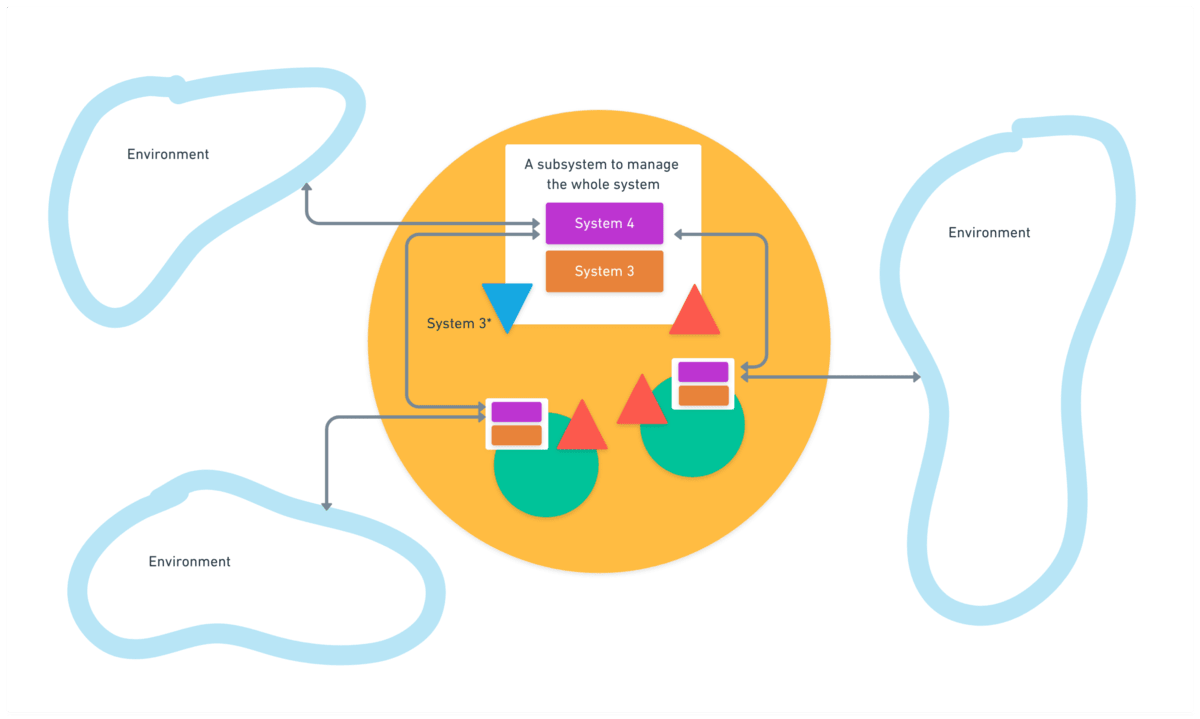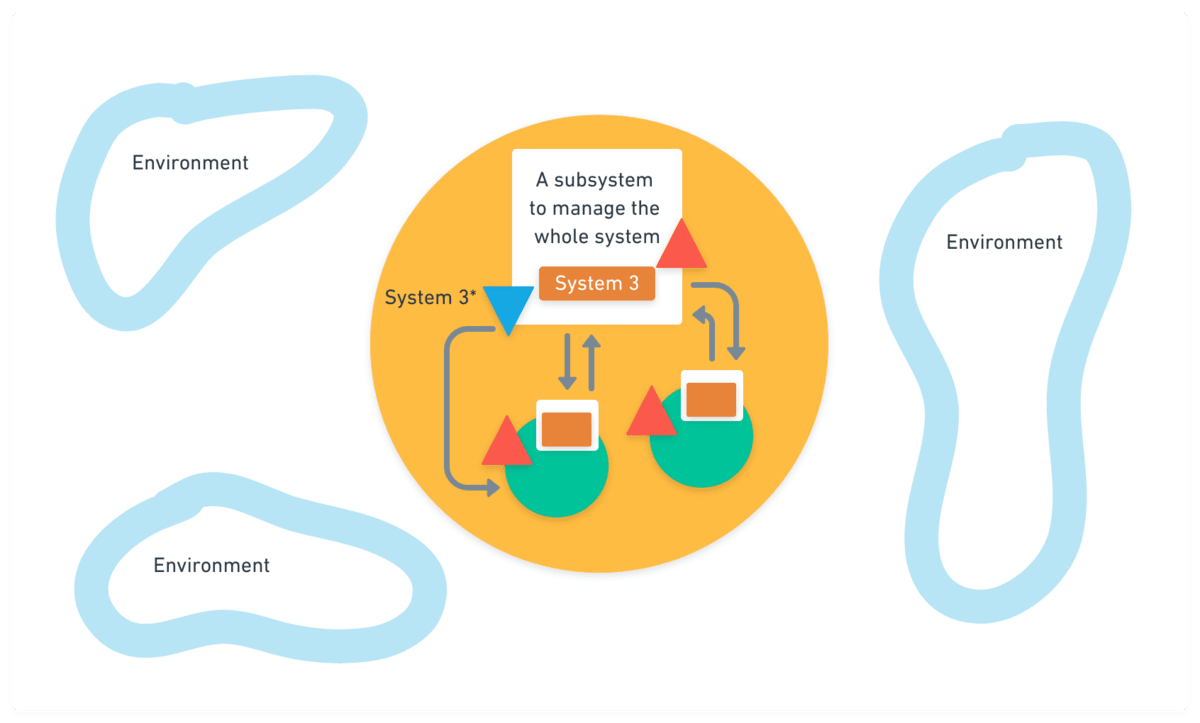TB871: Managing Development and Strategic Balance in the Viable System Model (System 4)
Note: this is a post reflecting on one of the modules of my MSc in Systems Thinking in Practice. You can see all of the related posts in this category.
The Viable System Model (VSM) comprises five systems. This post focuses on System 4:
System 4: Development and Planning — Focuses on the external environment and future planning. It involves activities related to market research, innovation, strategic planning, and adaptation to changes in the external environment. It ensures the organisation remains relevant and can respond to future opportunities and threats.
Taken from TB871: The five systems of the Viable System Model (VSM)

Within the VSM, System 4 plays a crucial role in managing development and maintaining strategic balance. The above diagram attempts to show this.
Managing Development
System 4 is tasked with ensuring an organisation remains viable by focusing on long-term development and adaptation. Its primary functions include:
- Environmental scanning: Continuously monitoring the external environment for changes and potential future shifts. This activity is vital for identifying strategic risks and opportunities.
- External communications: Handling communications that are not directly related to operations. This function ensures the organisation stays connected with external stakeholders and adapts to external expectations and trends.
- Innovation: Encouraging and implementing new ideas and methods. By encouraging a culture of innovation, System 4 helps the organisation evolve and stay competitive.
- Change management: Overseeing the processes of change within the organisation. This includes planning and implementing changes effectively to minimise disruption and maximise benefits.
- Organisational modelling: Developing and maintaining a model of the organisation to understand its structure, processes, and alignment with the external environment.
Failures in System 4 can lead to an organisation becoming rigid and unable to respond to external changes. There are many storied examples of this, including companies such as Kodak, Blockbuster, and Polaroid who failed to respond to changes in their environment, losing not only their sector-leading position, but eventually going bankrupt.
Strategic Balance
Balancing the present and future needs of an organisation is a key responsibility of System 4. Traditional strategic models often fall short because they rely on fixed goals and linear processes, which can be ineffective in a rapidly changing environment. Instead, the VSM advocates for a dynamic approach where strategy emerges from the organisation’s ongoing processes and interactions.
Strategic conversations which span the organisation are essential. The discussions involved should involve various stakeholders to ensure diverse perspectives and adapt strategies to real-time changes in the environment.
To achieve ‘strategic balance’ with System 4, it’s important to consider:
- Integration with System 3: Maintaining a dialogue between System 4 and System 3 (which focuses on present operations) ensures that immediate operational needs and future strategic objectives are aligned.
- Adaptability: Emphasising flexibility and responsiveness allows the organisation to adjust its strategies as environmental conditions change.
- Feedback Loops: Using feedback from the environment and internal operations to refine and adjust strategies continuously.
The interaction between Systems 3 and 4, moderated by System 5 (which oversees governance issues around policy and identity), ensures that the organisation can balance stability with the need for innovation and adaptation.
Applying System 4 to my system of interest
It’s really interesting to me to see System 4 as a separate system within VSM, as it’s probably the part in which I’m most interested and have spent my career doing. Let’s apply it to my system of interest, which is ‘a system to promote lifelong learning’ in a library setting:
1. Environmental scanning
System 4’s role in environmental scanning involves monitoring the external environment to identify trends, opportunities, and potential risks that could impact lifelong learning initiatives in the library.
In this context, the library should regularly review trends in education, technology, and community needs. For instance, understanding the rise of programmes relating to digital literacies or changes in community demographics can inform the development of relevant services. Community engagement is essential and conducting surveys and focus groups with both library users and non-users can help in identifying gaps and potential new services.
In addition, keeping track of local and national education policies and funding opportunities allows the library to adapt its programs in alignment with broader educational objectives and secure necessary resources.
2. External Communications
Managing non-operational communications with external stakeholders is important for building partnerships and promoting the library’s learning initiatives. To build effective partnerships, the library can collaborate with local schools, universities, businesses, and community organisations to create learning programmes and share resources.
Additionally, PR such as marketing campaigns can help raise awareness about lifelong learning opportunities available at the library. These campaigns can include social media outreach, newsletters, and community events to engage a wider audience. Ongoing communication with grant-making bodies and other funding sources is also vital to secure financial support for learning initiatives.
3. Innovation
System 4 creates an environment for innovation by encouraging the development and implementation of new ideas and methods to enhance lifelong learning.
Introducing new technologies (e.g. e-learning platforms and makerspaces) provides diverse learning experiences for library users. Developing programmes around this should focus on designing and testing innovative learning programs and workshops catering to different age groups and learning preferences — e.g. coding clubs for children, digital skills workshops for adults, and book clubs for retirees. Creating feedback mechanisms allows library users to suggest new ideas and provide feedback on existing programmess, leading to innovation, iteration, and improvement.
4. Managing Change
System 4 is responsible for managing change within the library, ensuring that new initiatives are implemented smoothly and effectively. This involves developing and implementing detailed change management plans to secure the successful introduction of new learning programmes and technologies. These plans should include timelines, responsibilities, as well as information around allocating resources.
Providing training and support for library staff helps them adapt to new programmes and technologies, which means they can assist users effectively. System 4 continuously monitors the implementation of new initiatives, gathers feedback, and makes necessary adjustments to improve effectiveness and user satisfaction.
5. Organisational Modelling
Another role for System 4 in this context is maintaining a comprehensive model of the library’s operations and its alignment with lifelong learning objectives. Developing and maintaining a strategic plan outlines the library’s long-term goals for promoting lifelong learning and the steps needed to achieve them.
Ensuring that resources (financial, human, and physical) are allocated in alignment with the strategic plan and learning objectives is crucial to success. Establishing performance metrics allows the library to evaluate the success of lifelong learning initiatives, such as attendance on programmes, user satisfaction, and learning outcomes.
References
- Hoverstadt, P. (2020). ‘The Viable System Model’. In Reynolds, M. & Holwell, S. (eds.) (2020). Systems Approaches to Making Change: A Practical Guide. London: Springer, pp.89-138.


